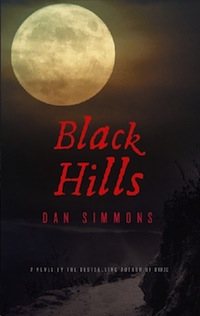Dan Simmons may be best known for his Hugo Award-winning far-future science fiction tetralogy, which includes Hyperion, Fall of Hyperion, Endymion, and Rise of Endymion. But he is equally at home with horror novels like the just-released Carrion Comfort, Summer of Night, and A Winter Haunting, and with the detective stories in his Joe Kurtz series.
Recent novels The Terror, about a real attempt to find the Northwest Passage, and Drood, which combines the life of Charles Dickens with the plot of the Dickens’ unfinished final work, combine intricately accurate historical plots with disturbing supernatural frisson. Look for more of the same in Black Hills, due out next week.
Regardless of plot or theme, four elements that define Simmons’ works are his thorough research, his literate writing style, his careful delineation of characters, and the vivid detail of his settings, whether on board space ships, on faraway planets or, as in Black Hills, on the grasslands of South Dakota, the Chicago World’s Fair and the face (and faces) of Mount Rushmore.
The book opens in the summer of 1876, as 10-year-old Paha Sapa (whose name means Black Hills in English) follows the warriors of his Lakota tribe to the Little Big Horn, an area the natives refer to as Greasy Grass. Although Paha Sapa has no intention of becoming a warrior and hopes to be a spiritual leader for the tribe, he is caught up in the moment and rushes onto the battlefield to count coup among the soldiers of the decimated 7th Calvary.
Thus, he touches George Armstrong Custer, just as the military leader’s soul is leaving his body.
The ghost of Custer enters the boy’s body and his mind and becomes a part of him for the next six decades.
Simmons deftly shifts back and forth through those next 60 years as Paha Sapa barely avoids death from both his own people and the white invaders, works as a performer in Buffalo Bill’s Wild West Show, becomes a dynamite expert in dangerous mines and ends up as the top blaster for the creation of Mount Rushmore, all the while battling the ghost that is the constant passenger in his mind.
In frequent asides, Custer’s ghost—which, at first, doesn’t realize he has died—reveals intimate details of his life and his love and passion for his wife, Libby.
Eventually the reader learns Paha Sapa’s real reason for working on the Rushmore Monument: the presidential likenesses are being carved from a mountain the natives call The Six Grandfathers, among the most sacred of Indian lands. Paha Sapa plans to blow up the monument so the Grandfathers can never be desecrated again.
Interwoven through the narrative is Simmons’ hidden ecological agenda, which implies a possible return to the time when the plains were filled with buffalo and other fauna long gone from the Black Hills. This is all made clear in the “Epilogue,” a short and fascinating addendum that is definitely not to be missed.
Black Hills is Dan Simmons at his best, a novel that should be enjoyed by fans of historical fiction, supernatural fiction or mainstream fiction in general. In fact, even those who prefer nonfiction accounts should be fascinated by this book.
Go to the author’s webpage to find a seven-minute video about the background and making of Black Hills.
Mark Graham reviewed books for the Rocky Mountain News from 1977 until the paper closed its doors in February 2009. His “Unreal Worlds” column on science fiction and fantasy appeared regularly in the paper since 1988. He has reviewed well over 1,000 genre books, including nearly all of Dan Simmons’ titles. His lengthy review of Drood appeared in the paper’s last issue on February 26, 2009. If you see a Rocky Mountain News blurb on a book, it is likely from a review or interview he wrote. Graham also created and taught Unreal Literature, a high school science fiction class, for nearly 30 years in the Jefferson County Colorado public schools.










